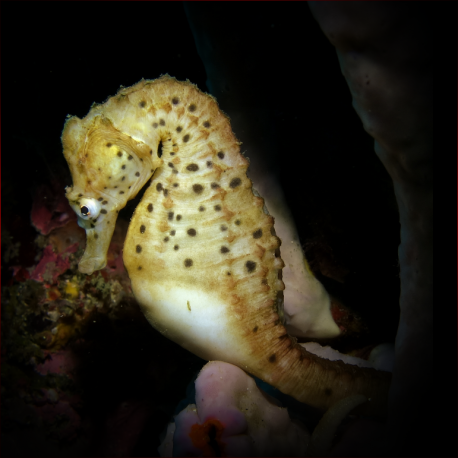More info
Datasheet
| Minimum Tank Size | 200 litres / 52.83 US gallons |
| Maximum Size | 35.0cm / 13.78inches |
| Reef Compatible | Always reef safe |
| Temperament | Peaceful |
| Temperature | 22.2°C / 71.96°F - 25.6°C / 78.08°F |
| Specific Gravity | 1.020-1.025 |
| Carbonate Hardness | 8-12 |
| pH | 8.1-8.4 |
General Description
The Big-belly seahorse, scientifically known as Hippocampus abdominalis, belongs to the Syngnathidae family, which includes unique species like Pipefishes and Seahorses. Native to Australia and New Zealand, this species can reach a maximum size of 35.0cm and is recognized for its distinctive appearance and delicate movements.
Aquarium Suitability
The Big-belly seahorse is considered suitable for special aquarium setups due to its specific requirements. It is essential to provide them with a tank tailored to their needs, ensuring a safe environment where they can thrive. These seahorses do well in pairs or small groups, emphasizing the importance of their social nature.
Demands, Care, and Hardiness
With an average hardiness level, this species has particular care demands in captivity. The aquarium water temperature should ideally range between 22.2-25.6°C (72-78°F), slightly cooler than standard marine setups. To maintain their health, enriching their diet with omega-3 and vitamins is crucial as they can easily become malnourished in captivity. Keeping them in a properly maintained tank with adequate filtration is essential for their well-being.
Reef Suitability
The Big-belly seahorse is known to be reef safe, making it a compatible addition to reef aquariums. However, precautions should be taken when choosing tank mates, particularly avoiding aggressive species and predatory fish that could harm these delicate creatures.
Aquarium Setup
Setting up an aquarium for the Big-belly seahorse involves creating a habitat that mimics their natural environment. Providing them with objects to latch onto, such as kelp or macroalgae, is vital for their well-being. It is recommended to avoid including corals or anemones in the tank, as they can harm the seahorses. Additionally, maintaining a gentle water current and ensuring a suitable tank size of at least 200 liters are key factors for their optimal care.
Behaviour
Described as peaceful in temperament, these seahorses thrive in a calm and undisturbed tank environment. They are not strong swimmers, so a moderate water flow is preferred to prevent stress on these delicate creatures.
Feeding and Diet
The Big-belly seahorse primarily feeds on small crustaceans like krill, mysis, and artemia. While they typically prefer live food, captive-bred specimens may readily accept frozen mysis, offering a more convenient feeding option. Ensuring a nutritious diet by supplementing their food with omega-3 and vitamins is essential for their overall health.
Dimorphism and Captive Reproduction
In captivity, this species can be bred successfully, making captive-bred individuals more readily available in the aquarium trade. Offering live food initially may be necessary for non-captive bred seahorses to encourage feeding. Captive breeding programs have contributed to the sustainability of these species, providing aquarists with a more accessible and potentially easier-to-care-for option.
Habitat and Distribution
The natural habitat of the Big-belly seahorse includes coastal waters of Australia and New Zealand. Their distribution in these regions emphasizes the importance of replicating their native environment when setting up an aquarium. Maintaining suitable water conditions with a pH of 8.1-8.4, a specific gravity of 1.020-1.025, and a carbonate hardness (kH) of 8-12 is crucial for their well-being.

